The first car bomb attacks on unarmed civilians began in early 2004. More than 200 Shias were killed on 2 March during the festival of Ashura as bombs ripped through crowds in the holy city of Kerbala and at the main Shia shrine in Baghdad in the northern suburb of Kadhimiya. Body parts and strips of flesh were scattered all over the blood-stained streets. The vast number of deaths, the biggest on a single day, as well as the symbolic impact of attacking unarmed pilgrims during a religious festival, shocked Iraqis.
“Our movement began as Shia but we have many Sunni members. History has taught us that nothing has happened between the Sunnis and the Shias in the past,” Duaffar said proudly. “I’m sure there won’t be sectarian clashes in the future. The Sunnis and the Shias know the enemy want to provoke clashes, but we are containing the danger successfully.” Duaffar was one of many political leaders who worked hard to prevent retaliation in the hours after the bombings at Kerbala and Kadhimiya. He assumed they were probably the work of Sunni militants from abroad or from the Salafis.
In March 2004 in Fallujah, which the Americans saw as a “Sunni bastion” and a hotbed of militant Islam, Abed Ruzuqi, a retired employee in the agriculture department, was keen to tell me that the town had a well-integrated Shia minority and there were no sectarian problems. As his brothers offered us rice and chicken at a shaded table in his front garden, he described an American attack a few nights earlier which, the Americans said, was a response to grenades being fired at a US patrol.
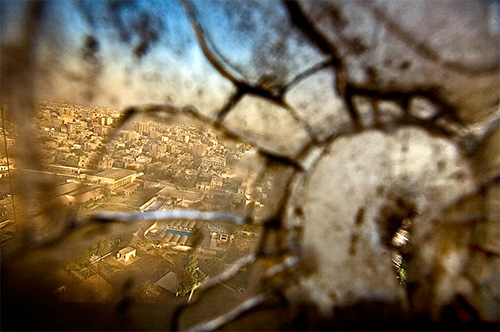
Photograph by Ben Lowy
Ruzuqi heard a helicopter in the night sky, with its lights doused as usual. Suddenly a minivan across the road went up in flames. After the chopper moved off, neighbors rushed out with buckets of water to put the fire out. When a helicopter engine was heard again, the neighbors fled. Ruzuqi’s elderly brother-in-law, Muwaiyed Abdul Munim, was too slow. As he neared his front gate he was struck by shrapnel from a rocket that crashed into the road. Severely wounded in the abdomen, his family took him to hospital, where he died. “The Americans say they are fighting terrorism, but it’s they who bring terror by using bombs and rockets on innocent people,” Ruzuqi said. His son was a policeman and, like many Iraqis, he denounced the killing of police, even as he praised the resistance to US troops.
Interspersed with his anger with the Americans, Ruzuqi explained Falluja’s solidarity with Shias. “About 5 per cent of the people here are Shias. We socialize with them. They intermarry. At first they came to the town as day laborers but now they have small shops and businesses. They’re bringing their whole families. House prices are going up,” he remarked in the familiar manner of suburbanites anywhere.
He boasted of how, after the bombings at the Shia shrines in Kerbala and Kadhimiya, imams used Fallujah’s many minarets to put out loud-speaker messages urging people to donate blood. “More than 1,000 people went to the main hospital here to give blood. I was one of them,” Ruzuqi said.
In Baquba, a mixed Sunni-Shia town about 50 miles north of Baghdad, I was almost set upon by students of the technical institute when I asked about sectarianism in April 2004. A protest demonstration had just taken place against the American onslaught on Fallujah and in support of the uprising in Sadr City by the radical Shia cleric, Moqtada al-Sadr. I asked whether both Sunni and Shia students took part. “We are not Sunni or Shia. We are Muslims,” one student shouted. Others called me a Zionist. “Why do you focus on whether people are Sunni or Shia?”, asked an older man who turned out to be a faculty member, as he tried to calm the crowd of enraged students who had started to jostle me. As he led me to safety I tried to explain I wasn’t “focusing” on the issue. It was just one of a range of subjects I wanted to understand.
The students’ irritation with me was well founded. Intermarriage between Sunnis and Shias was common, particularly among better-educated people, and many Iraqis refused to define themselves in sectarian terms. A survey in January 2004 by the Iraq Center for Research and Strategic Studies, one of Baghdad’s best opinion pollsters, asked people which of the following expressions “suits you well”: Sunni Muslim, Shia Muslim, or Just Muslim. The biggest category, 39.9 per cent, chose the last option.
Abu Abdullah was sure the murders were either the work of Iran, the USA, or Israel.
As the number of assassinations of Sunni imams gradually increased, Sunni leaders were as reluctant to blame Iraqi Shias as Shias had been to blame Iraqi Sunnis for the bombs at Kerbala and Kadhimiya or the assassination of Ayatollah Hakim. Sabah al-Qaisi, the AMS spokesman, accused “Iranian agents” of being behind the Kerbala and Kadhimiya bombings. Their motive, he suggested, was to prevent Iraq emerging as a stable and united state. He saw the murders of Sunni imams as a kind of slow-motion version of the bombings in Kerbala, with the same aim of trying to provoke revenge and civil war. When I spoke to him in Baghdad in April 2004, he told me:
- Shias have special holy days which mean a great deal to them, and they gather in large crowds. Sunnis don’t have big occasions so they go for individual targets … They hope they’ll provoke us by killing our leaders, and get an immediate reaction, but we will not act unreasonably.
The imams’ killers were trained in Iran and took their orders from Iranian security agents, he insisted. When I asked how he knew, his response was somewhat chilling:
- I started an inquiry and arrested a man who admitted he was an agent for a local militia which has relations with Iran. He confessed to killing several of our Sunni imams. We didn’t give him to the police, but transferred him to his family.
My interpreter explained later that this last phrase meant they killed the man.
To find victims of the spate of killings at Sunni mosques we drove to a low-income area of western Baghdad, a dusty suburb of wide streets with a mixed Sunni and Shia population. At the Hamed Findi al-Kubaisi mosque Sunni clerics took us to a side building in the front yard. One wall was covered in shelves with Qur’anic and other religious texts. The opposite wall on either side of the window was a grisly sight. Bits of black hair were stuck to the paint amid sinister brown stains of dried blood. “We kept this to show people,” explained Abu Abdullah, whose job it was to make the call to prayer.
A mosque guard had been sitting in the room one evening when a grenade was thrown from the street, the sheikh explained. He and the other guards rushed out of the mosque and saw a BMW that was similar to one they had spotted four days earlier when their imam, Ali Hassan, was walking to the mosque for evening prayers. About eight shots were fired from the car, killing the imam.
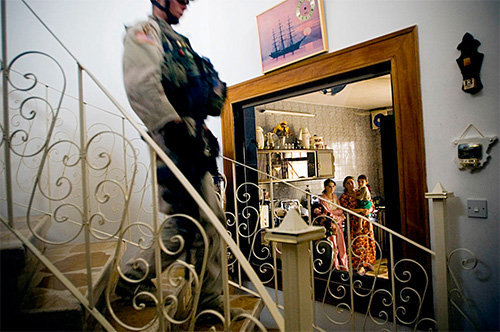
Photograph by Ben Lowy
Abu Abdullah was sure the murders were either the work of Iran, the USA, or Israel. “The attacks are done by Iraqis who come from Iran, or by Iranians,” he said. His other theory was that Americans and Israelis were responsible. “It could be Iraqi mercenaries paid by America or Israel. Since the Americans got here, they’ve been working to create a spark for a sectarian conflict. They will not succeed,” he said. As evidence, he cited the fact that US troops had come to the mosque a few hours before their imam was killed. They invited him to their headquarters to meet the local US commander. Photographs of the meeting were taken. “I believe this was done to give pictures to the killers to help them identify their target,” Abu Abdullah said. Whatever the validity of his claims, the significant point was that he refused to blame local Shias for the spate of murders: “It was not done by Shias. Inshallah, we will not fight each other.”
This phrase had become a mantra, repeated by every Iraqi politician at senior or local level, whenever the issue of civil war was raised. They included Sheikh Ghazi Ajil al-Yawer, a rich businessman who headed the Shammar, one of Iraq’s largest tribes with more than 2 million members. He was appointed by the Americans to serve on Bremer’s governing council in July 2003 and became Iraq’s interim president a year later.
The politicians say ‘I’m a Sunni’. People say ‘I’m an Iraqi.”
An imposing, portly figure in beautifully laundered white robes, he had an impeccable command of English. Two months before the Americans selected him as Iraq’s president, I visited him in his well-protected Baghdad villa. “We have Sunni and Shias in our tribe,” Sheikh Ghazi explained expansively:
- We stretch along most of western Iraq from the Turkish-Syrian border down to Saudi Arabia. We had a clash with the Wahhabis when they started. We migrated north of Euphrates in the eighteenth century. The people who
stayed south became Shias.
He was born in Mosul, and counted himself a Sunni, although “half the time I vote with the Shia in the governing council. I don’t like to be put in a corner.” As a child, his parents regularly took him to the Shia holy cities of Kerbala and Najaf for festivals, and his best school friend was a Chaldaean Christian. “I’m a believer and I do my religious duties every day. But I’m really secular. I never think about things in a religious way. You never find a Bedouin who goes to religious extremes,” he laughed engagingly.
The Americans had just conceded there would have to be elections to a constituent assembly—though not until January 2005. Sheikh Ghazi was worried that Shia parties would outbid each other to get support in the Shia community by taking anti-Sunni positions, either openly or in a disguised way by emphasizing social justice and the need to redress the economic wrongs of the past. Shias formed most of Iraq’s underclass and would understand what was meant.
At the time of our conversation, the sheikh insisted that sectarianism was only being raised by foreigners:
- Someone is trying to invent a sectarian problem in Iraq. It’s mostly outsiders … But there is trouble with the politicians here. People in the street are ten times more responsible than politicians. The politicians say “I’m a Sunni”. People say “I’m an Iraqi.”

Photograph by Ben Lowy
Sheikh Ghazi was not the only prominent Iraqi who saw the danger of sectarianism and sought to forestall it. Iyad Allawi, who was selected by the Americans to head the interim government that superseded the governing council in June 2004, firmly opposed sectarianism. He presented himself as a secular figure with national appeal. However, rather than promoting national reconciliation or reaching out to Sunnis as prime minister, Allawi made it his priority to defeat the occupation’s opponents. In August 2004 he encouraged the Americans to launch an assault on the holy city of Najaf to destroy Sadr’s Mahdi army. In November he approved the second US onslaught on Fallujah, code-named Operation Phantom Fury.
The two episodes were turning points.
The Americans failed to disarm the Mahdi army and from then on it was impossible for Sadr to do it for them by voluntarily disbanding his militia. He was bound to retain it as an anti-occupation force as well as a weapon in the struggle with the other main Islamic militia, SCIRI’s Badr organization.
On the Sunni side it was equally hard for politicians to maintain credibility as Arabs and as nationalists if they worked with the Americans. They were bound to be treated with suspicion, if not contempt, by other Sunnis. The attack on Fallujah left hundreds dead, destroyed more than half the town, ruined the electricity and water systems, and turned more than 350,000 people into refugees. Sunnis across Iraq were enraged. It was hardly surprising that most Sunni politicians refused to put up candidates for the January 2005 elections. They argued that free elections could not take place until foreign troops withdrew from Iraq’s cities.
‘We see no benefit in institutions designed to implement American plans. If the conference were to set a timetable for a US troop pullout, it would be worth it.’
A rare attempt not only to denounce sectarianism but to create a united front to fight it was made by a group that called itself the National Foundation Congress. It was put together in May 2004 by some 450 Iraqis who met at Baghdad’s Babylon Hotel shortly after the Kerbala and Kadhimiya bombings. They included pan-Arab Nasserists, leftists, and Baathists from the era before Saddam turned the party into a personal fiefdom, as well as representatives of the AMS. No Sadrists attended but a representative joined later. There were other Shias, both Islamist and secular, as well as Kurds and Christians. The Congress made two calls—for an early end to the occupation and for an end to sectarianism. It argued that the latter could not happen without the former.

Photograph by Ben Lowy
To meet the congress’s general secretary I went to Kadhimiya in July 2004. Less than 50 yards from the shrine where hundreds of pilgrims had been attacked in March, steps led up to a small gatehouse and then down into the courtyard of a Shia religious school. After removing my shoes I was ushered into a mercifully cool room with deep carpets and even deeper armchairs. Sheikh Jawad al-Khalisi and four guests rose in friendly greeting. While many Iraqi clerics exude a sanctimonious, mildly impatient air with foreigners despite their elaborate expressions of welcome, al-Khalisi had a look of genuine attentiveness. He listened and discussed rather than declaimed.
His grandfather, Mahdi al-Khalisi, was a distinguished ayatollah who led the Shia opposition to the British occupation in 1923. Arrested and deported, he took refuge in Iran. This pedigree of resistance was matched by Iraq’s other proud nationalists and Islamists, Moqtada al-Sadr and Harith al-Dhari; they also had parents and grandparents who had fought occupation. I found it a useful reminder of Iraq’s long history of occupation as well as of the importance of honor in Iraqi families. Each generation feels conscious of the nationalist legacy it has to protect.
Unfortunately, the pro-occupation people tend not to distinguish between resistance and terrorism or between anti-occupation civil society and those who use violence.
Although Khalisi did not reject armed resistance, his main point was that peaceful politics were not yet exhausted. The media’s focus on violence and Allawi’s stress on “defeating the insurgency” gave the impression that the Americans’ opponents only used force. This also implied that people who supported peace supported the occupation. The National Foundation Congress wanted national reconciliation but believed this could only happen once the Americans announced a timetable for withdrawal. Congress members would not take part in the US-supported national conference that the US embassy was trying to organize as a kind of surrogate legislature before the January elections. “We see no benefit in institutions designed to implement American plans. If the conference were to set a timetable for a US troop pullout, it would be worth it. But in the context of the occupation the conference is powerless and we don’t want to disappoint our supporters,” Khalisi said.
Wamidh Nadhmi, a veteran Arab nationalist and political science professor, stressed the National Foundation Congress’s role as a bridge between Iraq’s communities and a potential barrier against a collapse into sectarianism. He argued:
- National unity cannot grow in a country that emphasizes sectarian divisions or expects ethnic strife … There has to be reconciliation between Sunnis and Shias. We’re not interested in religion as such but we feel that by bridging the gaps the ground will be better prepared for a national struggle.
The real division in Iraq, he argued, was not between Arabs and Kurds, Sunni and Shia or secular and religious but between “the pro-occupation and anti-occupation camps”. In his view:
- the pro-occupation people are either completely affiliated to the US and Britain, in effect puppets, or they saw no way to overthrow Saddam without occupation. Let’s agree not to indulge in slander but discuss the issue openly. Unfortunately, the pro-occupation people tend not to distinguish between resistance and terrorism or between anti-occupation civil society and those who use violence. They call us all Saddam remnants, reactionaries, revenge-seekers, mercenaries, misguided, or foreigners.
By the autumn of 2004 attacks on Iraqi police and army recruitment centers were increasing in frequency. Car bombs in street markets and other places where civilians gathered were creating a climate of desperation. There were an average of 23 such incidents a month between June and September (a toll which was to increase three-fold in the next two years). Killing Iraqi police and other officials who collaborated with the occupation army was one thing. Detonating bombs among crowds of civilians was another. Who decided these tactics were legitimate? Were the bombs the work of Al Qaeda in Iraq alone? Were they also planted by the Iraqi resistance?
No one knew for sure. Groups like the National Foundation Congress denounced both types of attack. “The car bombs are intended to isolate the resistance from Iraqi people. I have some doubts about who is carrying them out,“ Khalisi told me. The AMS, which had close links to the resistance, rejected random acts of violence against civilians, though it was vaguer about the legitimacy of bombing Iraqi police and army recruits.
The attacks on police or civilians did not for the most part have sectarian motives, at least in 2004 and 2005. Spectacular outrages like the bombs set off by Al-Qaeda militants at Kerbala and Kadhimiya in April were clearly aimed at Shias, but the constant drip-drip of smaller attacks in various parts of Iraq seemed to have a wider purpose. They were meant to destabilize the new US-appointed government and create a sense that neither the Americans nor their close Iraqi allies could provide security for people. This type of terrorism had motives that were anti-occupation rather than anti-Shia.
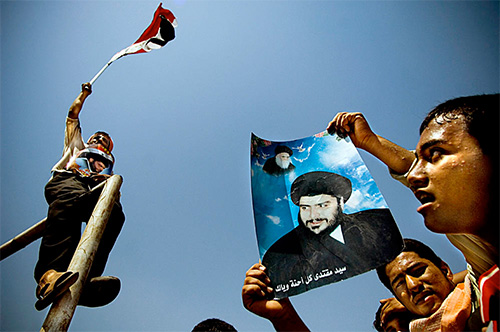
Photograph by Ben Lowy
Nevertheless, in small communities the violence could take on a sectarian tone. This was starkly illustrated by the killing of a group of Shias from Abbasiyat, a village south of Baghdad, who had signed up to join the Iraqi National Guard in November 2004. Police and army recruits tended to be Shias. This was not seen as “collaboration” by Shias, even by nationalist followers of Moqtada al-Sadr. He was happy for them to join the police and army since he wanted his men to be trained and paid. They could also provide a valuable future reserve since his main militia rival, the Badr organisation loyal to SCIRI, was infiltrating its supporters into both forces in large numbers. By contrast, any young Sunni who thought of joining the police or army would come under family and peer-group pressure, if not direct threat, not to do so.
The slaughter of young recruits at Abbasiyat hit the local Shia community hard. As Alissa J. Rubin put it in a powerful report in the Los Angeles Times: “Every one of Abbasiyat’s ten homes lost a son … A month after the attack, the sounds of women wailing still rose from the courtyards of the brick and mud homes.” Twelve men from the village had driven in a minibus to Baghdad to sign up for the Iraqi National Guard. On the way back at Latifiya, a largely Sunni town on the main road, they ran into a traffic jam where men dressed as Iraqi police pulled them over. They were told they were suspected of carrying explosives, according to the driver, who survived. The young men denied it but one of them, perhaps fatally, blurted out, “We are your brothers. We are all in the Iraqi National Guard and are protecting this country.” Like most vans owned by Shias, theirs had pictures of Imam Ali, the sect’s founder, on the dashboard, making their sectarian identity obvious.
The police led the minivan off the road. Two cars full of gunmen then forced it to drive into the desert to a small Shia mosque. There the men were beaten, disfigured, and ordered to curse the Shia saints, according to a survivor. Then they were shot, each about a dozen times. Before leaving the corpses in the mosque, the killers daubed graffiti on the walls: “Shia apes, idol-worshippers” and “No more Shias after today.”
When relatives approached the site several days later, armed men were waiting, perhaps to claim more victims. Only with the help of US troops and the police chief in the large town of Hillah did they manage to have the armed men arrested and retrieve the bodies. The bereaved families, all members of the Dohan clan, were convinced their sons’ murderers were from the Janabi tribe, a nearby Sunni group.
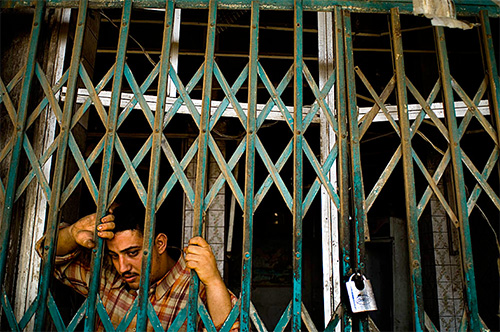
Photograph by Ben Lowy
In the days after the tragedy the Dohans met representatives of Ayatollah Sistani and SCIRI to seek permission to take revenge. In spite of the families’ anger, the clerics refused to authorize a vendetta. However, they saw the problem was serious and growing. More than 75 Iraqi police and guardsmen had been killed in the region in a three-month period. The clerics backed a proposal for a meeting between the chiefs of the Middle Euphrates tribes, where a letter was written to Prime Minister Allawi calling for action in response to “the killings in Latifiya that targeted Shias. We can’t keep silent about them. There must be a solution for this big problem, and if there is no solution, the tribes will take action themselves.”
Sheikh Ali Dohan, the clan chief, was still consumed with anger a month after losing his son in the incident. He would not stop recommending young Shias to join the army. He told me:
- We feel afraid but what choice do we have? We have to defend our country, and if we gave up sending our sons and others give up sending their sons the country will not work … The Janabis started the violence. They must be crushed. The criminals must be beheaded. This will deter those who are thinking of doing the same things. It’s the same as with Saddam. He was so brutal to stay in power and whoever is less than brutal will not succeed.
In microcosm, the Abbasiyat slaughter highlighted two looming new dangers. First, sectarian killings were prompting a clamor for revenge, and second, Iraq’s new security forces were increasingly becoming part of the problem. The more they became a preserve of Arab Shias (and Kurds), the more likely it was that Arab Sunnis would see them as a sectarian weapon in what they already perceived was a nationwide, US-supported, anti-Sunni campaign.
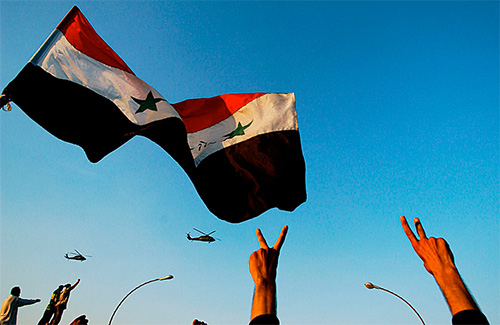
Photograph by Ben Lowy
Sectarianism was also deepening at the political level nationally. Although many Iraqi politicians made statements denouncing it, it had become the dominant factor in people’s electoral choices. The Bush administration called the January 2005 poll a triumph of freedom because it was the first contested vote Iraqis had been allowed for decades. But it was deeply flawed by the fact that most voters cast their ballots on sectarian or ethnic lines. The Shia Islamist list took 48 per cent of the vote, and the Kurdish list 26 per cent. Allawi’s secular list, the only major non-sectarian grouping, took only 14 per cent. Lists headed by secular former exiles Ghazi al-Yawer and Adnan Pachachi got a derisory 1.78 and 0.28 per cent respectively. The Islamic party took 0.25 per cent. Sunnis boycotted in droves, with a turnout of only 4,000 in Anbar province, the epicenter of US counter-insurgency operations where Fallujah and Ramadi are located.
By now the sectarian genie was truly out of the bottle. National politics were dominated by sectarian thinking. The army and police were turning into sectarian structures. Sectarian murders were growing in number and frequency.
Jonathan Steele is the author of Defeat: Why America and Britain Lost Iraq

